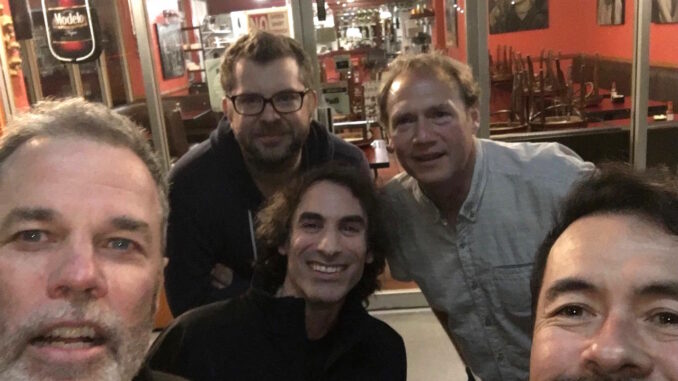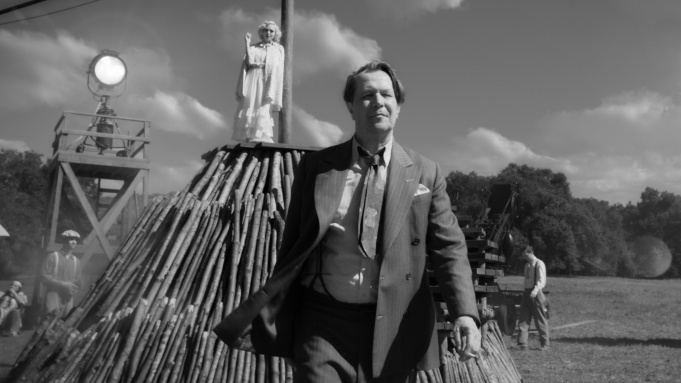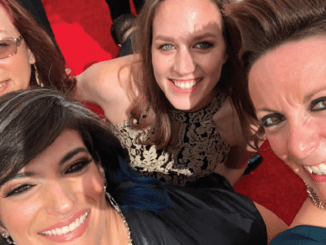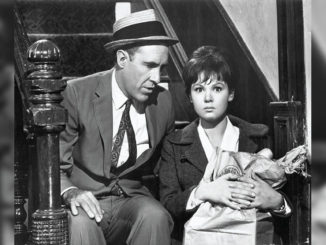
by Patrick Z. McGavin
Orson Welles famously observed a writer needs a pen, a painter a brush, and a filmmaker an army.
One of the soldiers behind Welles’ most fabled work is at the heart of David Fincher’s new Netflix film “Mank,” which excavates a creation myth from the contentious backstory of “Citizen Kane,” Welles’ 1941 feature directing debut. Many critics consider it one of the best films ever made.
Fincher commanded his own army of Foley artists, dialog editors and sound specialists for his iconoclastic biographical portrait of the screenwriter Herman J. Mankiewicz (Gary Oldman).
Verisimilitude was the most pressing concern in crafting a symphonic soundtrack of rare cars, Underwood typewriters and vintage telephones.
Sound designer/re-recording mixer Ren Klyce and supervising sound editor Jeremy Molod have worked on every Fincher movie since his breakthrough second feature, “Se7en” (1995).
“We know what Fincher is trying to get at when he is giving us directions,” Molod said. “Sometimes when he is asking us to provide certain sounds and he gives us a description of what the character or location is, it’s not always meant to be a literal translation.
“It’s more of a feeling and what he is trying to convey.”
Klyce assembled an impressive and highly experienced editorial team that included dialog editors Kim Fosacto and Richard Quinn, Foley editor Shaun Farley and the FX editor Malcom Fife and his team, Jonathon Stevens, Josh Gold and Coya Elliott.

Most important they all had a deep work background with the fastidiously exacting filmmaker.
Asked recently about his reputation as a perfectionist, Fincher told The New York Times Magazine: “There’s just a difference between mediocre and acceptable.”
“David really wants to comb every detail. We end up going through the soundtrack again and again, redoing this or that detail with a spotlight put on sound normally we wouldn’t have a spotlight put on,” Klyce said.
Like “Citizen Kane,” the new movie has a flashback structure. The story oscillates between 1940 with Mankiewicz composing the early drafts of the “Citizen Kane” script intertwined with colorful vignettes of his studio adventures at Paramount and MGM during the 1930s.
Fincher audaciously utilized modern technology to appropriate the sound and look of retro Hollywood. The pristine black and white photography of cinematographer Erik Messerschmidt, for example, was digitally scratched up and manipulated to represent 35mm film stock.
Fincher had an equivalent directive to the editorial team to have “Mank” sound as though it were mixed in 1939 with the technology available at the time.
“Fincher knew he was going to get the vintage sounds of the cars, the roads, the telephones and that world,” Klyce said. “His main concern was to make sure when he was watching the dailies he could get a sense of the film as sounding old fashioned.”
The team had a foundational work to reference.
“The movie is a companion piece in many ways to ‘Citizen Kane,’ and what we did was just start to watch that movie, and listen to it and realize what is it about ‘Citizen Kane’ that makes it sound old,” Klyce said.
“That put us off on a journey of discovery and experimentation, not just the sounds themselves, but in the actual sound of the film and the overall effect.”
Their work was also complicated by the pandemic, with much of the post-production work done remotely. The sound team operated like forensic specialists who went about the arduous and painstaking process of acquiring the necessary objects of Hollywood during the coming of sound.
Molod, Fife and Stevens secured access to three vintage 1930s cars and spent a day driving around Los Angeles, recording the sounds.
“Anything that was part of the environment of that world, we had to be as accurate as possible,” Fife said. “We were looking for any unique sound that we could fit.”
At the beginning of “Mank,” Welles (Tom Burke) and his producing partner, John Houseman (Sam Troughton) — given unprecedented creative freedom by RKO Pictures — hire the former theater critic to write a script modeled on the life of the media tycoon, William Randolph Hearst (Charles Dance).
The framing story is Mankiewicz sequestered at a bungalow in the desert town of Victorville, 85 miles northeast of Los Angeles. Suffering from injuries sustained in a car accident, the writer is attended by his secretary, Rita (Lily Collins) and his private German nurse (Monika Grossmann).
In the Victorville scenes, Fincher wanted a documentary exactitude.
“Fincher is really very keen on Foley,” Sean Farley said. “He is always asking why if he doesn’t hear the guy in the yellow sweater from 50 feet away.
“Everything in the film is covered, every movement, every glass pick-up. Fincher likes density and activity. Particularly in this story, I think that helps to sell the narrative. Their lives are very frenetic, and the movie reflects that with the foley. It’s a much denser sonic palette than you’d have of something that was actually filmed in the ‘30s.”
Inside the bungalow, every sound took on a privileged creative value, as the whirling blades of the fan. It could be due to the hip roof design or the general vintage interiors with high ceilings that made the sound reverberate all around and gave the place an old-school vibe.
“Everything in that Victorville scene had character,” Fife said. “Dusty winds, strange animals and trains going by. When John Houseman walks, the floor creaks more.
“It’s all very planned out.”
The sound design is not only meant to evoke a mood or atmosphere. It becomes a stabilizing force that fuses the disparate parts together.
The Underwood typewriter is the best illustration of how sound is deployed as a connective bridge.
Each leap back in time is established visually by typescript that flashes across the frame-“EXT. Paramount Studios – Day – 1930 (Flashback),” introduced by the rifling sound of the clacking typewriter keys.
“The typewriter sounds went through many iterations,” Klyce said. Getting the director’s approval was agonizing.
Each variation was followed by Fincher’s notes:
“It needs to sound heavier.”
“It needs to sound like paper.”
“That’s not right.”
Molod said the intense back and forth, trial-by-error working methods helped achieve the necessary alchemy of creative or resourceful solutions.

“It makes our job more difficult, but it also makes the film better,” Molod said. “One of the benefits of Fincher’s perfectionism is that he lets us know what he is thinking and what we should change.”
“Mank” alternates between two dominant narrative registers. The Victorville scenes are intimate and self-contained. The flashbacks are more frantic and densely populated, centered around backroom studio politics, writers’ meetings and gilded dinner parties at Hearst’s private estate, San Simeon.
The group scenes are shaped by verbal jousting and bickering reflective of the fast and quick-witted conversational style of the period.
As part of their preparation, Molod said they recorded a group of voice actors in Los Angeles. Dubbed the “Loop Squad,” these voice performers did their own research about 1930s Hollywood that helped the editorial team capture the spontaneity, vocal rhythms and period slang.
They not only provide a lot of the secondary or background sounds. Their contributions also paid off given the particular challenges posed by the multiplicity of voices.
In the early rough mix worked out of the offline editing machine of picture editor Kirk Baxter, ACE, Klyce said they received notes complaining of not being able to understand what was being said.
“When you work on a project so long, you get so familiar there is a tendency to add more sound effects, or music, like the scene when Charlie Lederer (Joseph Cross) meets the other writers,” Klyce said.
“We realized we had to strip away the background sounds, turn down all the music and make sure whoever was watching for the first time can grasp the dialogue. We wanted it clear and upfront.”
Whether a private exchange or a group dynamic, the dialogue editors played a monumental role in shaping the soundtrack.
“We did a lot of ADR,” Fosacto said. “Dialogue tends to be more about reconstructing, fixing and cleaning what you already have.
“When you have effects, you are adding something that’s not really there. It’s there visually, but wasn’t recorded sonically.”
The most important relationship in the film is Mankiewicz’s connection with the gifted Hollywood comedienne Marion Davies (Amanda Seyfried), who was Hearst’s companion.
Two illustrative scenes showcased the work of Fosacto and Quinn. The two bookend sequences, one during the day, the other at night, involve Mankiewicz and Davies walking through the vast grounds of San Simeon, passing through gardens and Heart’s private zoo.
The two scenes are intricately choreographed with gliding camerawork. In the open air, every word exchanged signifies the developing rapport of the two.
“Every single line of their dialogue was redone in the recording studio,” Klyce said. “David wanted to change their performance. When dialogue gets re-recorded, everything around the actor that was there originally disappears, the footsteps, the clothing.
“We had to reverse engineer all the sounds that would be there but weren’t, her bare feet, the crushed falls, the slosh of the water, the sounds of the elephants and monkeys.”
Near the end of the movie, Mank has a dramatic and drunken monologue inside the high ceilinged interiors of San Simeon that turns dark and accusatory.
“They wanted that (atmosphere) to be a real character,” Quinn said. “The whole idea was to make people uncomfortable, with the uncomfortable silence, or the uncomfortable murmurs.
“My work there is to help make it as clean we could and support the mood of the scene as Mank is going further and further off the rails.”
Achieving the proper sound patina required its own technical sleight of hand.
“Before the temp mix, the picture was delivering its version of the patina,” Fife said. “The problem we had was it was really affecting the choices we were making before the film was done editing.
“We made a choice to clear the patina out before the first temp. We made a choice to come back to it toward the end when we were done with the mastering to get the proper patina.”
The sound was recorded digitally and converted through the FX into analog to satisfy Fincher’s mandate to have it sound like an old phonograph.
At a scoring stage at Skywalker Sound, a massive room with a 60-foot screen, with back speakers that created an echo. Klyce and his team set up 12 mics in pairs and arranged them within different distances from the screen.
They played back the whole film and re-recorded the echo.
“If you watched the film without listening,” Fife said, “unless you recognize some of the actors’ faces, there is nothing in there that would tell you the movie was made later than 1939.”
Patrick Z. McGavin is a Chicago-based writer and cultural journalist.





